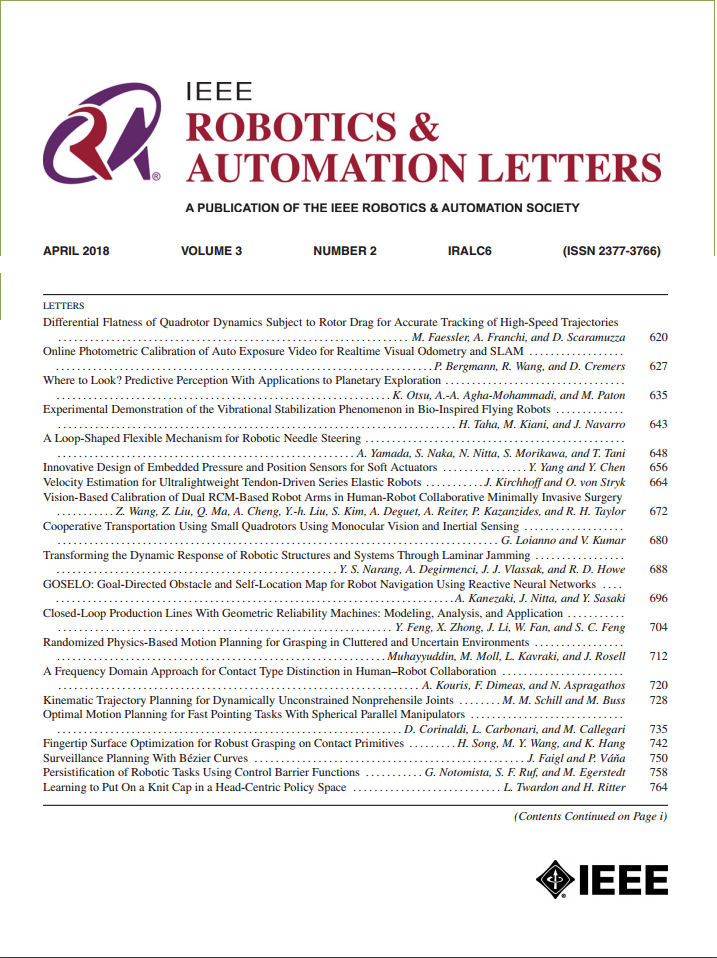自主农场海藻生长最大化:在不确定洋流中运行的动力不足系统的动态规划方法
IF 5.3
2区 计算机科学
Q2 ROBOTICS
引用次数: 0
摘要
海藻生物量为减缓气候变化提供了巨大的机会,但要实现其潜力,必须将养殖扩展到广阔的开放海洋。然而,在开阔的海洋中,锚定农场和拥有强大引擎的浮动农场在经济上都是不可行的。因此,一种潜在的解决方案是,利用最小的推进力来策略性地利用有益的洋流。在这项工作中,我们专注于低功率自主海藻养殖场和设计控制器,通过利用洋流最大化海藻生长。我们首先引入一个动态规划(DP)公式来求解真实电流已知时的生长最优值函数。然而,在现实中,只有不确定性增加的短期不完善的预测是可用的。因此,我们提出了三个额外的扩展。首先,我们使用频繁的重新规划来减少预测误差。其次,为了优化长期增长,我们通过基于季节平均电流估计预期的未来增长,将价值函数扩展到预测范围之外。最后,我们引入了一个贴现有限时间DP公式,以解释未来海流估计中日益增加的不确定性。我们在实际海洋条件下对农场进行了30天的模拟,以经验评估我们的方法。我们的方法仅使用5天预测就实现了95.8%的最佳可能增长。这表明,在现实条件下,低功率推进是一种很有前途的自主海藻养殖场运营方法。本文章由计算机程序翻译,如有差异,请以英文原文为准。
Maximizing Seaweed Growth on Autonomous Farms: A Dynamic Programming Approach for Underpowered Systems Operating in Uncertain Ocean Currents
Seaweed biomass presents a substantial opportunity for climate mitigation, yet to realize its potential, farming must be expanded to the vast open oceans. However, in the open ocean neither anchored farming nor floating farms with powerful engines are economically viable. Thus, a potential solution are farms that operate by going with the flow, utilizing minimal propulsion to strategically leverage beneficial ocean currents. In this work, we focus on low-power autonomous seaweed farms and design controllers that maximize seaweed growth by taking advantage of ocean currents. We first introduce a Dynamic Programming (DP) formulation to solve for the growth-optimal value function when the true currents are known. However, in reality only short-term imperfect forecasts with increasing uncertainty are available. Hence, we present three additional extensions. Firstly, we use frequent replanning to mitigate forecast errors. Second, to optimize for long-term growth, we extend the value function beyond the forecast horizon by estimating the expected future growth based on seasonal average currents. Lastly, we introduce a discounted finite-time DP formulation to account for the increasing uncertainty in future ocean current estimates. We empirically evaluate our approach with 30-day simulations of farms in realistic ocean conditions. Our method achieves 95.8% of the best possible growth using only 5-day forecasts. This demonstrates that low-power propulsion is a promising method to operate autonomous seaweed farms in real-world conditions.
求助全文
通过发布文献求助,成功后即可免费获取论文全文。
去求助
来源期刊

IEEE Robotics and Automation Letters
Computer Science-Computer Science Applications
CiteScore
9.60
自引率
15.40%
发文量
1428
期刊介绍:
The scope of this journal is to publish peer-reviewed articles that provide a timely and concise account of innovative research ideas and application results, reporting significant theoretical findings and application case studies in areas of robotics and automation.
 求助内容:
求助内容: 应助结果提醒方式:
应助结果提醒方式:


